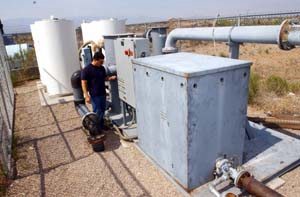Toxic
waste system is a winner
Photo
by: Max Becherer
Staff
Project coordinator Danny Samorano checks the air injection/
extraction system honored as
Environmental Public Works Project of the Year.
Harrison
Road landfill cleaned at little cost
to the city or to environment
By
Tim Ellis ARIZONA DAILY STAR
A system to clean up toxic waste at the old Harrison Road
landfill is doing a great job, city and state environmental
officials say. And because it's doing a great job for a
relatively low cost, the American Public Works Association
has cited the Harrison Road Landfill Remediation System
as the Environmental Public Works Project of the Year in
its category.
The category is for projects that cost less than $2 million
in contract and consultant costs.
Danny Samorano, project manager with the city Environmental
Management Division, said it cost about $1.2 million to
set up the system to remove chlorinated hydrocarbons that
are seeping from the landfill into the ground water. Including
staff time would push the total closer to $2 million, Samorano
said.
The system was needed because the old landfill had no lining
at the bottom to keep the chlorinated-hydrocarbon-bearing
substances from leaching out, he said.
The city closed the landfill, at Harrison and East Irvington
roads, in 1997. The remediation system went into effect
in 1998, Samorano said.
The primary contaminant in the chlorinated hydrocarbons
is PCE, or perchloroethene, which comes from degreasing
solvents in refuse dumped into the landfill, he said.
The solvents were buried in the 120-acre landfill before
federal regulations made that illegal in the mid-1980s,
Samorano said. Some monitoring wells at the landfill detected
the PCE in 1995, he said. An investigation was begun and
completed in 1997; the deep-soil vapor extraction/injection
system was designed and completed in 1998.
That's pretty quick for an environmental remediation project,
he said. Sam Rogers, a hydrologist with the Arizona Department
of Environmental Quality's Solid Waste Unit, agrees.
"The good news is they've removed a lot of contaminants,
and stopped the movement of contaminants from the site,"
said Rogers, who oversees the Harrison remediation system
and about 40 similar projects statewide. "They're doing
a pretty good job." The system will have to be in place
a minimum of five more years, he added.
Karen Masbruch, director of the Environmental Management
Division, said she believes this is the first application
of deep soil vapor extraction/injection technology to any
landfill.
"We are thrilled with the recognition" from the
public works association," Masbruch said. "I believe
that in the next few years, this innovative technology will
be widely used as an effective remedial action at landfills
throughout the Western United States."
Samorano said city officials will accept the award at the
public works association's annual convention in Kansas City.
·
Contact Tim Ellis at 807-8414 or at ltellis@azstarnet.com.
One
well injects clean air as 3 extract pollution
How
does it work?
The
Harrison Road Landfill Remediation System uses three deep-extraction
wells around the perimeter of the old Harrison Road landfill,
all of them bored down to a point just above the water table.
A fourth well, bored into the center of the landfill, injects
clean air into the ground, which helps push contaminated
vapors toward the edges. The three extraction wells collect
the vapors. The contaminated air is then circulated through
carbon filters, and the resulting clean air is returned
to the atmosphere.
The system also helps reduce ground-water contamination
with a well that is down-slope from the old landfill, said
Danny Samorano, project manager with the city Environmental
Management Division.
Contaminated ground water is captured in that well and treated
with carbon, then injected with bacteria that microorganisms
feed on. That water is then reintroduced into the aquifer,
Samorano said.
The ground-water cleanup system works well with another
system to deal with an additional problem caused by the
Harrison landfill, Samorano said. That is methane gas, which
is produced naturally by decomposing garbage at all landfills.
At sufficient concentrations, methane can cause explosions.
The city must monitor methane production at landfills to
make sure it doesn't migrate through the ground to adjoining
properties, as it did in the early and mid-1990s. The city
also must report excessive levels of methane to the state
Department of Environmental Quality.
Samorano said the two systems work well together to prevent
pollutants from seeping through the soil, horizontally and
vertically, down into the water table.
"It's pretty cost-effective technology, and when compared
to similar sites, it's a winner," Samorano said.
- Tim Ellis
All content copyright © 1999, 2000, 2001, 2002 AzStarNet,
Arizona Daily Star and its wire services and suppliers and
may not be republished without permission. All rights reserved.
Any copying, redistribution, or retransmission of any of
the contents of this service without the expressed written
consent of Arizona Daily Star or AzStarNet is prohibited.
|